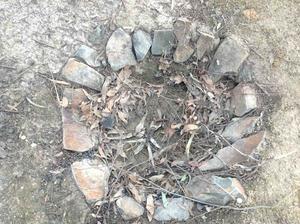Home / Resources / Significant episodes / Hands on activities II
Hands on activities II
Sandra Barnes
Worowa College
Healesville Cluster
Finding 3.6: Student Voice
Realise that responsive mathematics pedagogy builds on student voice, recognition of diverse ways of learning mathematics and connection to worlds beyond the classroom (both local and non-local).
Student A was having a lot of difficulty with dividing numbers. I could see she was blanking out when I was explaining with the blocks. I was using language like ‘divide’ and ‘split into equal groups’. So I got ten blocks and said that they were herself and her friends. I made up names for the blocks and talked to them saying things like, ‘Have you known your friend for a long time?’
Then I said there were two campfires and got her to draw them. She drew two circles.
I said, ‘You and your friends are cold, they want to go to the fire but there has to be the same number of people at each fire.’ She quickly put five at each fire. After a while four more people joined each fire and she put four more blocks at each fire. Then I got three trucks and pretended to drive them over to the fire. I said, ‘All get in. We are going fishing. Same number of people on each truck’. She immediately put the blocks equally on each truck. I then showed how we would show that in numbers using the division sign. We played for a bit longer, modelling the story then writing the equation and she got it. Next day she went straight to a worksheet on division and got it all right.
Now I practise tables with campfires or swimming holes. We draw it in the traditional style where a circle is the campfire and U is a person. The stories are endless, such as:
- Five campfires
- One at each campfire and you only have five people
- Two at each campfire and you have ten people
- Three at each fire etc.
Some questions to prompt discussions with your colleagues:
- What contexts or stories could you use to teach division that would be relevant to your Aboriginal students?
- What mathematics could be represented by the drawing in the image?
- What other interesting or important aspects are in this Significant Episode?
Hands on activities II
Download the PDF of this significant episode.
hands_on_activities_3.6.pdf 521.48 kB

